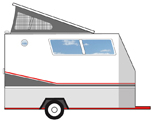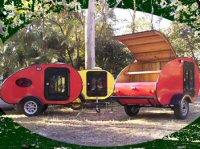Besides 'sparking' around with stuff since Ham Radio at age 12 - as with other grown-up Geeks on here - I thought I'd chime with some minutiae based on [over]wiring my own House w/o Code violations.
1. 2 Tandem 15 Amp'ers sound good. Of course, you never mix Breakers and Panels between Vendors; they each have different form factors. It's also smart to not recycle a 'very old' Box w/new Breakers for this same reason. I was going to suggest a Small Panel w/2 Tandems before it was posted above; a sound plan.
2. An Electrical Pro Contractor pal uses good ole Square D Homeline Series on all his Projects, and does a lot of huge Yuppie Houses with 2 - 200 Amp Panels, etc.. Insane amounts of Electricity wiring in some. Hey, 7,500 sq. ft. Houses @ 8,000' elevation w/Home Theaters; Elevators [yep]; Electrically-heated Driveways and Roof edges to melt Snow; dual A/Cs or Heat Pumps; and 4,000 Bottle temp-controlled Wine Cellars suck some Amps! He's also upgraded some Panels in my modest 'Hood with the same Brand due to Big Box pricing and superb reliability.
FYI, Square D also has one Series that breakers DC in the same Breaker form factor.
Breakers aren't 'binary' and don't trip at 15.1 Amps. They work from thermal 'overload' on a sliding scale. At 110% of rated load, they trip in a leisurely 'x' seconds. At 125% or 150% of rated load, they trip much faster. Being thermal-based, ambient temp matters some. So, in the theoretical scenario where a nearly-maxed out Breaker running 2 Appliances doesn't trip in one scenario [Winter] and does in another [Summer], that could be what's going on. Not that your proposed design will have this issue [it won't]; I'ze just sayin'...
3. On the Wire Charts and Specs, there's a sort of identical 'sliding scale' on Wire Specs. #14 AWG [or #12, etc.] actually will handle more current, but is
conservatively rated for the Specs we're all throwing around above in enclosed Walls @ 100% duty cycle and spec'ed temp 'x'.
#12 AWG Solid is tough to manipulate. As with any Wire size, #14 can handle MUCH longer wiring runs than you're contemplating. So, you still have ratings 'conservatism' or leeway built into your design while using all-#14 AWG Wire. There's even Specs 'gimme' on ambient temperature, and whether Wires are run individually in free air [better ambient cooling] or bundled together [as in Portable Cordage a.k.a. Extension Cords]. These are fine points that won't affect your design at all, but worth knowing to not over-build or lose sleep.
4. Some folks on here really like stranded vs. solid Wire in moving 'things', so cutting up Cordage makes sense. Also, it has tougher outer Insulation by Code and by manufacturing convention. Of course, any Idiot knows you can't use green Xmas Cords any other time of the year!

5. Take care in stripping Wire Insulation to keep all stranded Wires intact. Wrap the twisted strands carefully around Outlet Screws to obtain full surface contact area to lower contact resistance. Cut off lil strays, if any. Always provide a lil wire 'slack' to de-tension all connections. I use Electrician's 'Pliers' with pre-set 'stops' for #12 and #14 Wire. They strip Insulation w/o nicking Copper.
The install pictured above looks mighty macho, and worth following technique-wise. Who wants to muck with failures inside finished Walls?
6. My TTT, and most others, use beefy #10 - 30 Amp Portable Cordage Cable w/integral Park Pedestal 'Cat's Eye' Connector that then wires straight into the TTT Power Center. Mine coils up inside adjacent to my Sink. That's a time-tested way to go. Some RVers consider the lil TTT side panel pass-through to be a Mouse intrusion 'bottleneck'. In other cases, some folks - and I might do this - install a weather-proof, Marine-grade Twist Lok to eliminate the Mouse hole infirmity, and allow bulky Cable storage elsewhere. A pro RVer tells me of some RV Cords now being cut off of Big Rigs in storage, all for the Copper to sell! But, that's not a concern of mine, having safe storage House-side.
If it's an issue, note now in your design that 30 Amp RV and Generator Connector outputs are different. Each have their own convention: 'Cat's Eye' vs. Twist Lok. You would want to wire a RV Park Pedestal 30 Amp Connector onto the #10 Cable, and then adapt that to a Genny output, as seen on any Genny example w/outputs >20 Amps.











 My side cutters wouldn't do it without stripping away the outer insulation first.
My side cutters wouldn't do it without stripping away the outer insulation first.
